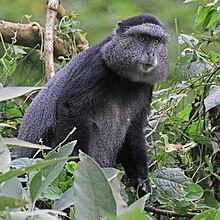Blue monkey
| Blue monkey | |
|---|---|
 |
|
|
C. m. stuhlmanni Kakamega Forest, Kenya |
|
| Scientific classification | |
| Kingdom: | Animalia |
| Phylum: | Chordata |
| Class: | Mammalia |
| Family: | Cercopithecidae |
| Genus: | Cercopithecus |
| Species: | C. mitis |
| Binomial name | |
|
Cercopithecus mitis Wolf, 1822 |
|
| Subspecies | |
|
6, see text |
|
 |
|
| Range map (note: includes the range of the closely related Sykes', silver, and golden monkey) | |
6, see text
The blue monkey or diademed monkey (Cercopithecus mitis) is a species of Old World monkey native to Central and East Africa, ranging from the upper Congo River basin east to the East African Rift and south to northern Angola and Zambia. It sometimes includes the Sykes', silver, and golden monkey as subspecies.
Several subspecies are recognised:
At times some of these have been regarded as full species, additional subspecies have been considered valid, while others are not recognized by all authorities.
Lake Manyara National Park, Tanzania
Lake Manyara National Park, Tanzania
C. m. stuhlmanni
Kakamega Forest, Kenya
C. m. stuhlmanni
Kakamega Forest, Kenya
Despite its name, the blue monkey is not noticeably blue: it has little hair on its face, and this does sometimes give a blue appearance, but it never has the vivid blue appearance of a mandrill, for example. It is mainly olive or grey apart from the face (which is dark with a pale or yellowish patch on the forehead - the "diadem" from which the species derives its common name), the blackish cap, feet and front legs, and the mantle, which is brown, olive or grey depending on the subspecies. Typical sizes are from 50 to 65 cm in length (not including the tail, which is almost as long as the rest of the animal), with females weighing a little over 4 kg and males up to 8 kg.
...
Wikipedia

